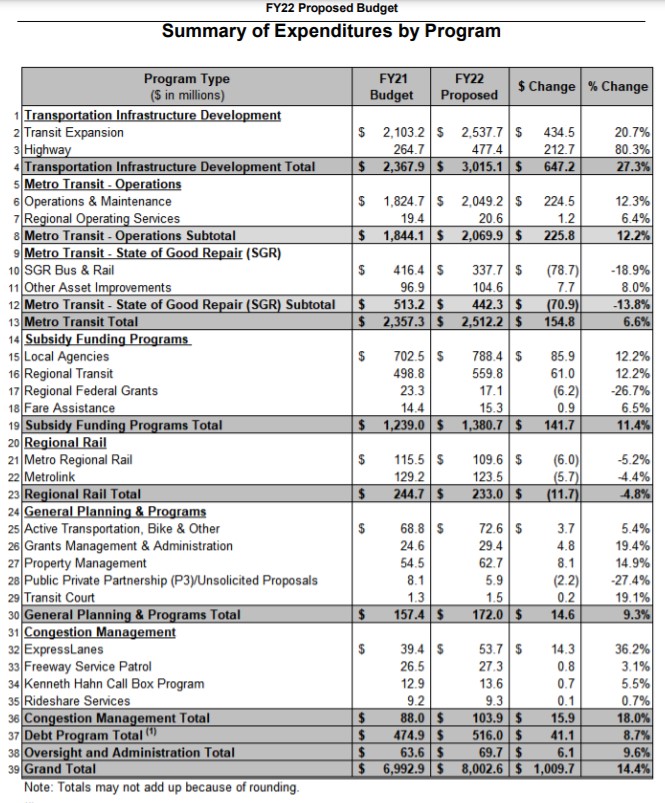Scratching the Surface of Metro’s Proposed FY21-22 Budget
3:46 PM PDT on May 13, 2021
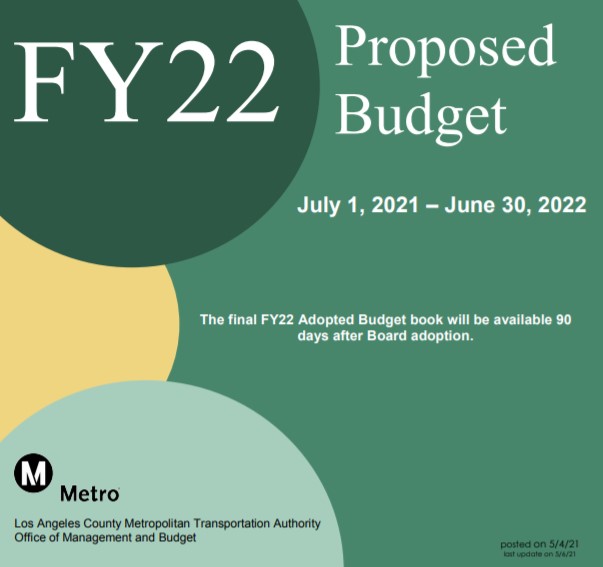
It's budget season for Southern California agencies. Today Streetsblog takes a look into Metro's proposed $8 billion budget for Fiscal Year 2022, which will begin June 1, 2021. Metro is seeking public input on the FY22 budget. The board will discuss and vote on the budget in its Finance Committee meeting (and concurrent Budget Public Hearing) next Wednesday and at the full board meeting on May 27.
Metro FY22 budget information is available in an 18-page presentation and an 83-page detail document, as well as several earlier budget development presentations: revenues/resources, transit/highway/regional rail capital expenditures, and transit operations and maintenance.
The good news is that Metro's overall fiscal situation is healthy.
Last year, the pandemic and economic downturn caused the agency to make fairly steep cuts - including a twenty percent cut in overall transit service, impacting buses somewhat more than rail. Mid-year, finances were better than anticipated. Metro hesitatingly made plans to gradually restore transit service to pre-pandemic levels - initially scheduled for July 2021, then pushed back to September 2021.
Metro's pandemic shortfalls in sales tax and fare revenue were more than made up for by receiving more than $3.3 billion dollars worth of federal COVID monies:
- Coronavirus Aid, Relief, and Economic Security (CARES) Act - March 2020 - Metro received and spent $846 million.
- Coronavirus Response and Relief Supplemental Appropriations Act (CRRSAA) - December 2020 - Overall, Metro received ~$833 million, though broken out in several categories: $747 million for transit agencies, $38.2 million for transportation capital (used to free up funding for LAX connector), and $47.6 million passed along to municipalities for transportation expenses.
- American Recovery Plan (ARP) - March 2021 - Final numbers do not appear to be available yet - and ARP expenditures can be spread out from now through 2024. Metro anticipates receiving the lion's share (should be around $1.35 billion) of ~$1.6 billion for L.A. County transit agencies. ARP also has $277 million that essentially back-filled sales tax shortfalls for several Metro transit projects already under construction.
- FEMA COVID funds - There is some additional FEMA money (details are scant) that Metro is seeking. So far Metro has asked for a $145 million reimbursement that includes $80 million for law enforcement costs.
The proposed FY22 budget includes quite a bit of CRRSAA money, but neither the ARP transit monies nor FEMA funds. (It also doesn't include the still-in-flux fareless pilot, which the board is expected to vote on this month.)
Overall the FY22 budget is $8 billion, a 14 percent increase over last year's budget.
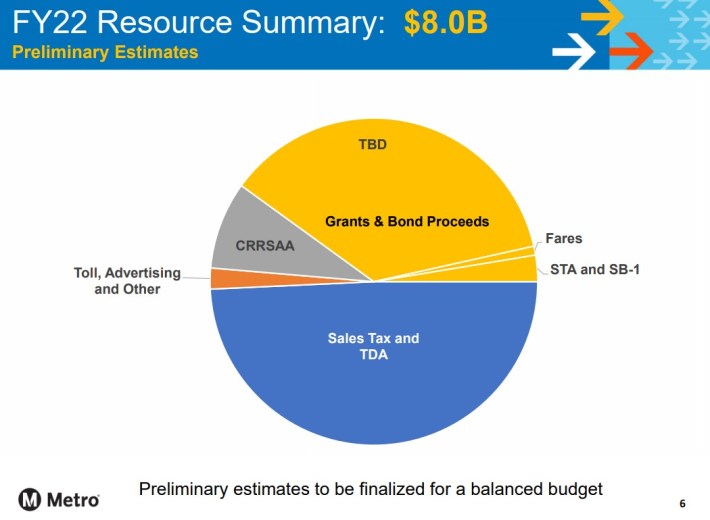
As is fairly typical for Metro, sales tax is the largest source of revenue, with transit fares accounting for very little.
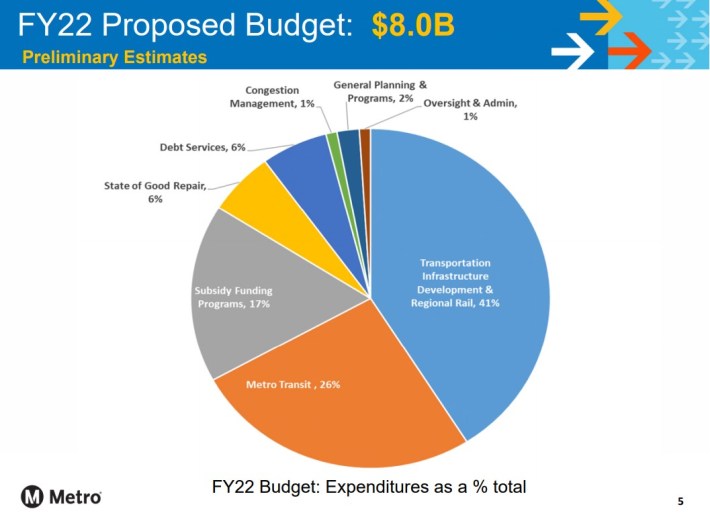
On the spending side, capital expenditures continue to outpace transit operations.
One poor trend is that capital expenditures are increasing for highway projects much faster than for transit projects.
Highway capital spending would increase 80 percent, while transit capital would see a 20 percent increase. Though, overall, for direct Metro capital spending, transit construction ($2.538 billion) is still significantly more than highway construction ($0.477 billion.) Note that Metro passes some monies through to municipalities for their own capital projects, where expenditures serving driving vastly outpace other modes.
Growth of highway spending is a bad sign - especially as many Metro highway projects have come under criticism for harmful impacts to communities, housing, environment, climate, etc. The highway construction budget increases appear to be less of a deliberate board policy than to be somewhat related to the timing of new funding, including: Trump-era grants (that favored highways), new state gas tax monies awarded to highway projects, and longstanding highway projects passing from planning phases to construction phases.
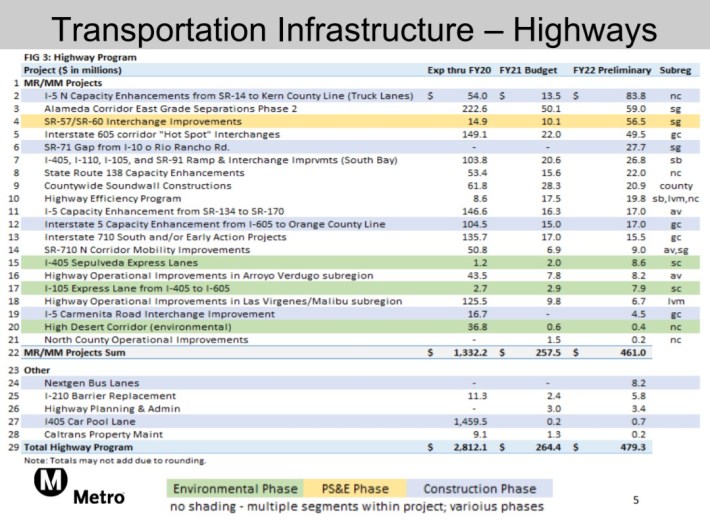
To a large extent, Metro sales tax revenue is segregated - assigned to a specific purpose: highways, transit, operations, etc. - so the growth of the highway capital budget doesn't necessarily take away from other types of spending. Nonetheless, if Metro is to achieve its stated goals - equity, reducing single-occupancy vehicle use, staving off climate change - the agency should not be increasing its highway spending.
Transit construction continues on the half-dozen new rail lines that many Streetsblog readers are familiar with. Construction should be wrapping up on the Regional Connector and Crenshaw/LAX lines, with testing getting underway for openings expected in early FY23. Construction will also get underway on two new transit projects: the LAX Connector and East San Fernando Valley light rail.
Metro touts transit operations returning to pre-COVID levels in September 2021. This is better than the Metro staff's earlier recommendation (December 2021), but overall annual operations spending remains below pre-COVID years. Some operations monies are going to promising new programs (alternatives to policing, customer experience programs) but other operations funds are going to questionable ones (conventional policing, MicroTransit.)
Stay in touch
Sign up for our free newsletter
More from Streetsblog Los Angeles
Metro Board Funds Free Student Transit Pass Program through July 2025
Metro student free passes funded another year - plus other updates from today's Metro board meeting
Eyes on the Street: New Lincoln Park Avenue Bike Lanes
The recently installed 1.25-mile long bikeway spans Lincoln Park Avenue, Flora Avenue, and Sierra Street - it's arguably the first new bike facility of the Measure HLA era
